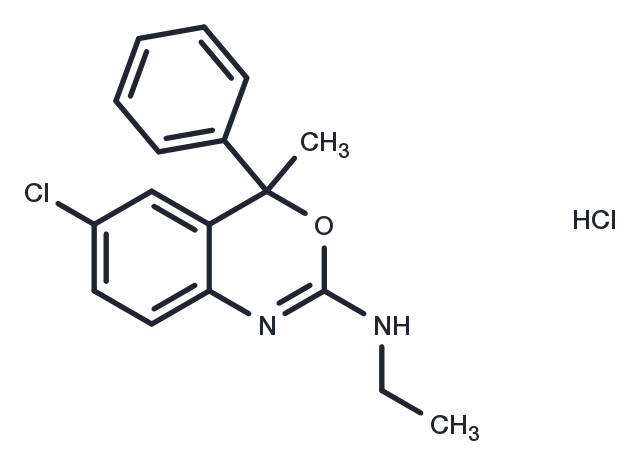Powder: -20°C for 3 years | In solvent: -80°C for 1 year


Etifoxine hydrochloride (HOE 36-801 hydrochloride) is an anxiolytic and anticonvulsant drug. Unlike benzodiazepines, Etifoxine hydrochloride appears to produce its anxiolytic effects by binding to β2 and β3 subunits of the GABAA receptor complex, and so is acting at a different target site to benzodiazepines, although the physiological effect that is produced is similar to that of benzodiazepines.

| Pack Size | Availability | Price/USD | Quantity |
|---|---|---|---|
| 2 mg | In stock | $ 34.00 | |
| 5 mg | In stock | $ 55.00 | |
| 10 mg | In stock | $ 80.00 | |
| 25 mg | In stock | $ 153.00 | |
| 50 mg | In stock | $ 278.00 | |
| 100 mg | In stock | $ 493.00 | |
| 1 mL * 10 mM (in DMSO) | In stock | $ 61.00 |


| Description | Etifoxine hydrochloride (HOE 36-801 hydrochloride) is an anxiolytic and anticonvulsant drug. Unlike benzodiazepines, Etifoxine hydrochloride appears to produce its anxiolytic effects by binding to β2 and β3 subunits of the GABAA receptor complex, and so is acting at a different target site to benzodiazepines, although the physiological effect that is produced is similar to that of benzodiazepines. |
| Synonyms | HOE 36-801 hydrochloride |
| Molecular Weight | 337.24 |
| Formula | C17H18Cl2N2O |
| CAS No. | 56776-32-0 |
Powder: -20°C for 3 years | In solvent: -80°C for 1 year
DMSO: 50 mg/mL (148.26 mM), Sonification is recommended.
You can also refer to dose conversion for different animals. More
bottom
Please see Inhibitor Handling Instructions for more frequently ask questions. Topics include: how to prepare stock solutions, how to store products, and cautions on cell-based assays & animal experiments, etc.
Etifoxine hydrochloride 56776-32-0 Membrane transporter/Ion channel Neuroscience GABA Receptor TBPS Anxiolytic γ-Aminobutyric acid Receptor disorder HOE 36-801 Hydrochloride HOE 36-801 inhibit adjustment Etifoxine Inhibitor Gamma-aminobutyric acid Receptor HOE 36-801 hydrochloride Etifoxine Hydrochloride inhibitor
